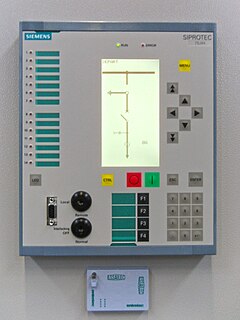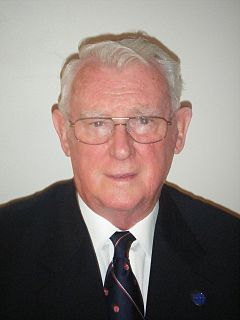The Canada Gairdner International Award is given annually by the Gairdner Foundation at a special dinner to five individuals for outstanding discoveries or contributions to medical science. Receipt of the Gairdner is traditionally considered a precursor to winning the Nobel Prize in Medicine; as of 2020, 95 Nobel Prizes have been awarded to prior Gairdner recipients.
The J. J. Ebers Award was established in 1971 to foster progress in electron devices. It commemorates Jewell James Ebers, whose contributions, particularly to transistors, shaped the understanding and technology of electron devices. It is presented annually to one or more individuals who have made either a single or a series of contributions of recognized scientific, economic, or social significance in the broad field of electron devices. The recipient is awarded a certificate and check for $5,000, presented at the International Electron Devices Meeting.
IEEE W.R.G. Baker Award provided by the Institute of Radio Engineers (IRE), was created in 1956 from a donation from Walter R. G. Baker (1892–1960) to the IRE. The award continued to be awarded by the board of directors of the Institute of Electrical and Electronics Engineers (IEEE), after the IRE organization merged into the IEEE in 1963. Recipients received a certificate and honorarium "for the most outstanding paper reporting original work" in one of the IEEE publications, including the transactions, journals, proceedings, and magazines of the IEEE Societies. The award was discontinued in 2016.
The IEEE Edison Medal is presented by the Institute of Electrical and Electronics Engineers (IEEE) "for a career of meritorious achievement in electrical science, electrical engineering or the electrical arts." It is the oldest and most coveted medal in this field of engineering in the United States. The award consists of a gold medal, bronze replica, small gold replica, certificate and honorarium. The medal may only be awarded to a new leap/breakthrough in the technological area of science.
The IEEE Medal of Honor is the highest recognition of the Institute of Electrical and Electronics Engineers (IEEE). It has been awarded since 1917, when its first recipient was Major Edwin H. Armstrong. It is given for an exceptional contribution or an extraordinary career in the IEEE fields of interest. The award consists of a gold medal, bronze replica, certificate and honorarium. The Medal of Honor may only be awarded to an individual.
The IEEE Simon Ramo Medal is an award for exceptional achievement in systems engineering and systems science, and was established by the IEEE Board of Directors in 1982. The medal is named for Simon Ramo, one of the founders of the TRW corporation. The award itself consists of a gold medal, bronze replica, certificate and honorarium. It may be presented to individuals, or groups of up to three people.

The IEEE Alexander Graham Bell Medal is an award honoring "exceptional contributions to communications and networking sciences and engineering" in the field of telecommunications. The medal is one of the highest honors awarded by the Institute of Electrical and Electronics Engineers (IEEE) for achievements in telecommunication sciences and engineering.

In utility and industrial electric power transmission and distribution systems, a numerical relay is a computer-based system with software-based protection algorithms for the detection of electrical faults. Such relays are also termed as microprocessor type protective relays. They are functional replacements for electro-mechanical protective relays and may include many protection functions in one unit, as well as providing metering, communication, and self-test functions.
The IEEE Founders Medal is an award is presented for outstanding contributions in the leadership, planning, and administration of affairs of great value to the electrical and electronics engineering profession. It may be presented to an individual or team up to three in number. This medal was established by the Institute of Radio Engineers (IRE) in 1952. The medal continued to be awarded after the merge of the IRE with the American Institute of Electrical Engineers (AIEE) in 1963 to form the IEEE. Recipients of this medal receive a gold medal, bronze replica, certificate, and cash honorarium.
The IEEE Richard Harold Kaufmann Award is a Technical Field Award of the IEEE that was established by the IEEE Board of Directors in 1986. This award is presented for outstanding contributions in industrial systems engineering.
The IEEE Frederik Philips Award is a Technical Field Award that was established by the IEEE in 1971. The award is presented for outstanding accomplishments in the management of research and development resulting in effective innovation in the electrical and electronics industry. This award may be presented to an individual or team of up to three people. Recipients of this award receive a bronze medal, certificate, and honorarium.
The IEEE Photonics Award is a Technical Field Award established by the IEEE Board of Directors in 2002. This award is presented for outstanding achievements in photonics, including work relating to: light-generation, transmission, deflection, amplification and detection and the optical/electro-optical componentry and instrumentation used to accomplish these functions. Also included are storage technologies utilizing photonics to read or write data and optical display technologies. It also extends from energy generation/propagation, communications, information processing, storage and display, biomedical and medical uses of light and measurement applications.
The IEEE Haraden Pratt Award was established by the IEEE Board of Directors in 1971. This award is presented to recognize individuals who have rendered outstanding service to the IEEE.
The IEEE Donald G. Fink Prize Paper Award was established in 1979 by the board of directors of the Institute of Electrical and Electronics Engineers (IEEE) in honor of Donald G. Fink. He was a past president of the Institute of Radio Engineers (IRE), and the first general manager and executive director of the IEEE. Recipients of this award received a certificate and an honorarium. The award was presented annually since 1981 and discontinued in 2016.
The Computer Pioneer Award was established in 1981 by the Board of Governors of the IEEE Computer Society to recognize and honor the vision of those people whose efforts resulted in the creation and continued vitality of the computer industry. The award is presented to outstanding individuals whose main contribution to the concepts and development of the computer field was made at least fifteen years earlier. The recognition is engraved on a silver medal specially struck for the Society.
The William M. Habirshaw Award was an award given by the IEEE and, prior to the formation of the IEEE in 1963, by its predecessor the AIEE, from 1959 through 1986 for outstanding contributions to the field of electric transmission and distribution. Starting in 1987, the award was renamed as the IEEE Herman Halperin Electric Transmission and Distribution Award. Herman Halperin had been a recipient of the Habirshaw Award in 1962 and had worked for 40 years for the Commonwealth Edison Company.
Carlos Katz is an American electrical engineer, researcher and the recipient of the 2010 IEEE award. His area of research is the properties and methods of manufacture of extruded and laminar dielectric high voltage power cables, and extension of service life of installed cables. He has written papers about the effects of water treeing on the life of cable installations.

Roy Billinton is a Canadian scholar and a Distinguished Emeritus Professor at the University of Saskatchewan, Saskatoon, Saskatchewan, Canada. In 2008, Billinton won the IEEE Canada Electric Power Medal for his research and application of reliability concepts in electric power system. In 2007, Billinton was elected a Foreign Associate of the United States National Academy of Engineering for “contributions to teaching, research and application of reliability engineering in electric power generation, transmission, and distribution systems."
Steven Allan Boggs was an American physicist in the field of dielectrics and electrical insulation. He was a researcher in industry before becoming a tenured research professor at University of Connecticut from 1993 to 2013.


